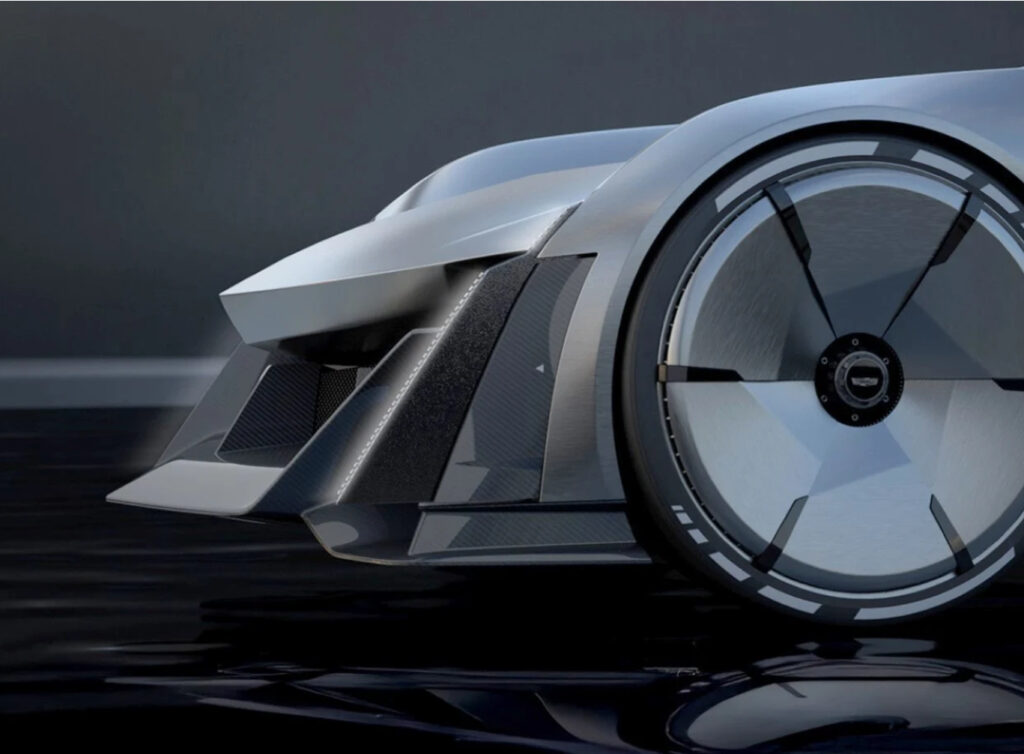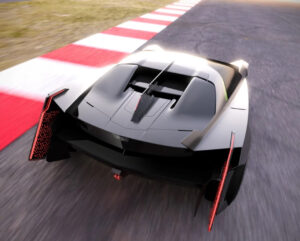If Bruce Wayne ever traded Kevlar for couture, this is what he’d drive.
There are concept cars, and then there are cinematic declarations. The Cadillac Fuertiq, designed by Byungwoo Ryu, isn’t just a car—it’s a full-throttle vision of luxury weaponized into form. Imagine Bruce Wayne, post-therapy, still harboring a taste for the dramatic, but choosing to express it in carbon fiber and composure instead of cape and cowl. The Fuertiq is that choice made visible: dark, poised, and predatory. It’s not just a fantasy vehicle—it’s a design thesis on power, restraint, and elegance pushed to its extreme.
From the first glance, the Fuertiq dares you to misread it. At a distance, it could be mistaken for a stealth aircraft mated with an opera house. It’s all edges and curvature, a balance of brutalism and grace. The silhouette crouches low, wide, and slightly forward—predatory, yes, but not unhinged. It doesn’t snarl. It whispers. With menace.
This is not your average luxury coupe. It’s an architectural object, masquerading as a car. Every surface feels intentional, every cut a statement. The body panels seem drawn from obsidian—dark, faceted, reflective but impenetrable. The visual language is sharp but never chaotic. The Fuertiq’s design doesn’t scream. It lectures. It speaks in the tone of a CEO delivering bad news calmly. And you listen.
Power, Encoded in Geometry
Byungwoo Ryu’s approach is unmistakably geometric. The Fuertiq’s design walks a tightrope between precision and performance art. Unlike the curvilinear seduction typical of Italian supercars, this machine is stoic, disciplined. It’s built not for temptation, but intimidation. Think brutalist architecture in motion. There’s something almost tactical about the proportions—long hood, low roofline, barely-there overhangs, massive stance. This is a car that was designed to own space as much as it occupies it.
The front fascia alone is a masterclass in controlled aggression. There are no oversized grilles or gratuitous vents. Instead, it uses absence as presence. Thin, blade-like LED lights pierce the darkness like incisions. The surface treatment is pure stealth, more matte than gloss, more void than volume. It doesn’t try to impress—it assumes authority.
The flanks carry strong bone lines, as if the car was hewn from monolithic material. You get the sense that nothing on this vehicle was added for flair. It’s all function—and when function is this beautifully resolved, flair becomes irrelevant. The wheel arches don’t flare, they encase. The rear tapers with surgical clarity, finishing in a tail that feels more like the stern of a yacht than a road car.
What Gotham’s Billionaire Drives When He Grows Up
The Fuertiq feels like the next evolution of Batman’s ride—not the armor-plated Tumbler or the outlandish Batmobile, but a civilian machine of intimidating elegance. It’s what Bruce Wayne would design if he finally gave in to his alter ego’s obsession with control and aesthetic minimalism. The car has the language of menace but the posture of restraint. It doesn’t chase criminals. It leaves them speechless.
It’s this dichotomy—lethal but refined, theatrical yet minimal—that makes the Fuertiq more than just concept art. It functions as character design for a machine. It’s not just about lines and surfaces. It’s about psychology. This is a car with a backstory.
You can imagine the sound it makes: low-frequency thunder, smooth but guttural, like a controlled demolition. It doesn’t need to be loud to be heard. It speaks in subsonics. Its presence is enough. You don’t drive the Fuertiq to be seen. You drive it to make others disappear.
The Future of Cadillac? Or an Alternate Timeline?
It’s worth asking: what does a concept like the Fuertiq say about Cadillac? This isn’t a vehicle aimed at your average luxury buyer. It’s mythmaking on wheels. In an era when legacy automakers are recalibrating identity in the electric age, the Fuertiq takes a bolder stance. It says: we remember when cars were dreams. And we still know how to build one.
There’s no badge bloating here, no desperate branding overkill. If anything, the Cadillac identity is understated—reduced to an emblem, a geometry, a silhouette. It’s the opposite of the shouty performance arms race among luxury manufacturers. This car could park next to a Ferrari SF90 or an Aston Martin Valhalla and make them feel overdressed.
The Fuertiq is what happens when a design team is allowed to go philosophical. It’s not concerned with production feasibility or global market segments. It asks deeper questions: What does luxury look like when you subtract everything unnecessary? What does power feel like when it’s disciplined? These aren’t spec-sheet questions. They’re emotional, psychological, even spiritual.
Interior as Command Center
Though the interior has only been glimpsed in renderings, the visual language follows suit—minimal, structured, noir. Expect an interior that feels more cockpit than cabin, more sanctuary than dashboard. Materials would likely favor stone-inspired composites, dark chrome, and matte leathers. No gimmicks. No overload of screens. Just tactile precision.
One can imagine how the interface would be designed. Haptic controls. Subtle ambient lighting. A heads-up display that feels less like tech and more like a whisper of data across the windscreen. The Fuertiq’s interior isn’t designed for interaction—it’s designed for intention. It’s a space where you don’t fidget. You execute.
Design Beyond Transportation
What sets the Fuertiq apart isn’t just its silhouette—it’s its philosophy. This is speculative design at its most resolved. It uses the language of automotive form to ask questions about status, fear, elegance, and identity. It’s not trying to be a daily driver. It’s trying to be a mirror for power—what it looks like, how it’s wielded, and what it says when it’s silent.
Byungwoo Ryu, the designer behind this piece of rolling noir, understands something many car designers forget: great design doesn’t just move people physically. It moves them emotionally. The Fuertiq doesn’t want you to think about torque. It wants you to think about why you want to disappear behind its tinted glass in the first place.
There’s also a cinematic quality at play here. You don’t just imagine driving it. You imagine the camera angles. The slow pan across the fascia. The glint of city lights across its surface. It’s not a vehicle. It’s a scene.
In a World of Noise, This Car is Silence
We live in a design moment saturated with overcommunication. Everything wants your attention. The Fuertiq flips that script. It’s a car designed to say very little—but everything it says cuts deep. It’s not loud. It’s not friendly. It doesn’t need your approval. It needs a shadowy garage under a penthouse tower. A dark road at midnight. A reason.
This is not a car for everyone. It’s not even a car for someone. It’s a symbol—of a future that values quiet power over flamboyant performance, of confidence without chaos, of elegance sharpened into edge. The Fuertiq is the design equivalent of a tailored suit with a concealed blade stitched inside.
The Last Word
If Cadillac were to build the Fuertiq tomorrow, it wouldn’t be a car—it would be an event. But even as a concept, it functions beautifully. Not because it will be produced, but because it reminds us what car design can be when freed from the burden of compromise.
The Fuertiq is what happens when haute becomes language, when menace becomes art, and when design dares to dream in the dark. It’s not a Batmobile. It’s something quieter. Something more dangerous. Something far more refined.
It’s the car Bruce Wayne would drive if he decided Gotham needed fear—but delivered in black-tie formalwear.
No comments yet.









